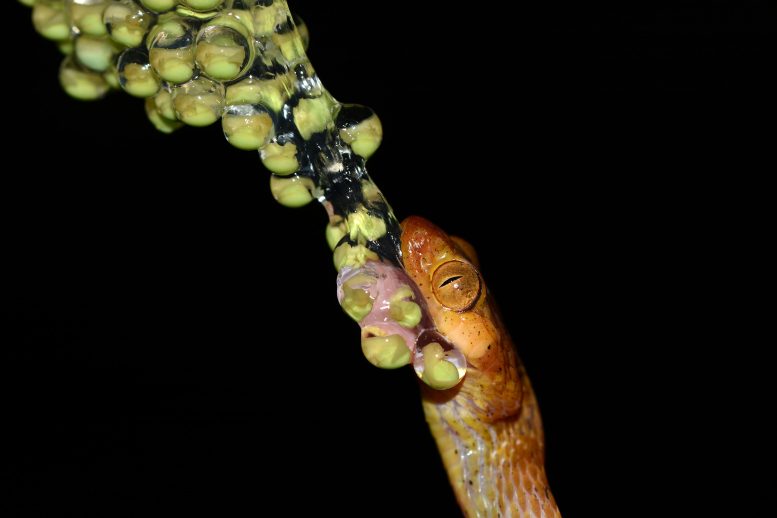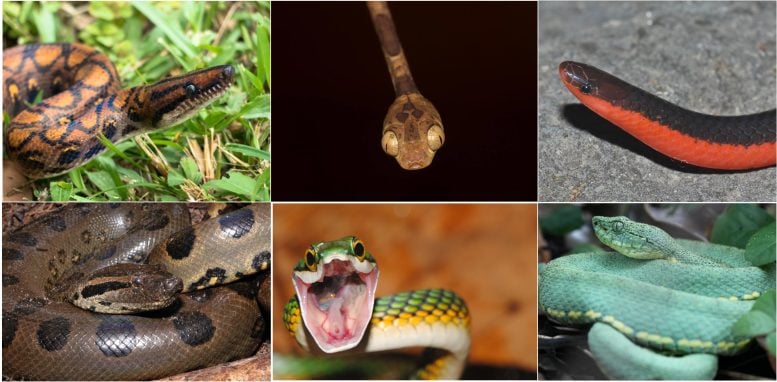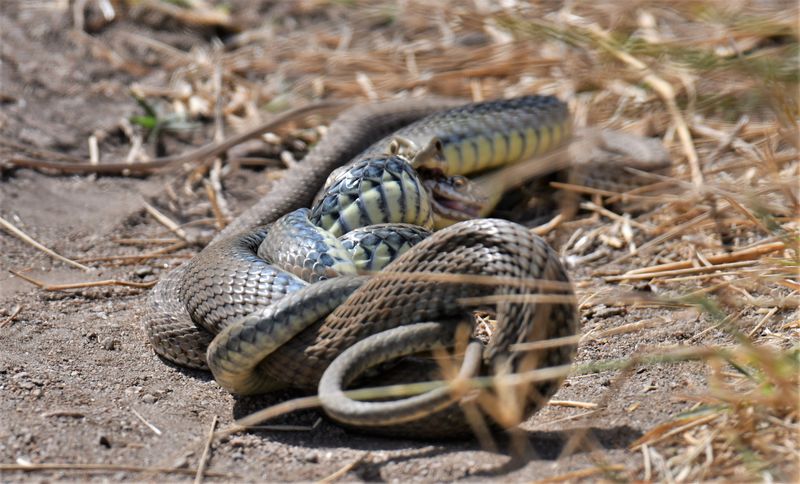SERPENTOLOGY
Snakes Diversified Explosively After the Dinosaurs Were Wiped Out 66 Million Years Ago

A blunt-headed tree snake (Imantodes inornatus) eating its way through a batch of treefrog eggs. Credit: John David Curlis, University of Michigan Museum of Zoology.
Sudden burst of evolution 66 million years ago expanded snake diets and put vertebrates on the menu.
The remarkable diversification of mammals and birds after the demise of the dinosaurs 66 million years ago is well known; but what happened to the snakes? According to a study published in the open-access journal PLOS Biology by Michael Grundler at the University of California, Los Angeles and Daniel Rabosky at the University of Michigan, snakes experienced a similarly spectacular burst of evolution from unassuming insectivorous ancestors to diverse lineages that included the newly available birds, fish and small mammals in their diets.
The K-Pg mass extinction event 66 million years ago – during which 75% of species, including all non-avian dinosaurs, went extinct – marked the beginning of the Cenozoic era and opened a myriad of empty niches for the surviving species to exploit. Like mammals and birds, snakes diversified rapidly during the Cenozoic era, resulting in the nearly 4,000 species that we see today.
To better understand the pace and sequence of this phenomenon, the researchers collated published data on the diets of 882 living snake species and used sophisticated mathematical models to reconstruct how the diets of their ancestors changed and diversified since the K-Pg boundary. They found that the most recent common ancestor of living snakes was insectivorous, but after the K-Pg boundary, snake diets rapidly expanded to include birds, fish, and small mammals – vertebrate groups that were also flourishing in the wake of the dinosaurs’ extinction.

A sampling of snake diversity. Clockwise from upper left: rainbow boa (Epicrates cenchria), image credit Pascal Title, U-M Museum of Zoology; Amazon basin tree snake (Imantodes lentiferus), image credit Pascal Title, U-M Museum of Zoology; western worm snake (Carphophis vermis), image credit Alison Rabosky, U-M Museum of Zoology; two-striped forest pitviper (Bothrops bilineatus), image credit Dan Rabosky, U-M Museum of Zoology; parrot snake (Leptophis ahaetulla), image credit Ivan Prates, U-M Museum of Zoology; and green anaconda (Eunectes murinus), image credit Dan Rabosky, U-M Museum of Zoology. These species show considerable variability in their diets, ranging from generalist predators on vertebrates (rainbow boa, anaconda) to species that specialize on sleeping lizards (tree snake), earthworms (worm snake), and tree frogs (parrot snake).
The study sheds light on the explosive adaptive radiation that gave rise to modern snake diversity. Diet diversification in snakes slowed after the initial radiation, but some lineages experienced further bursts of adaptive evolution. For example, Colubroid snakes diversified when Old World ancestors colonized North and South America. These findings show that mass extinctions and new biogeographic opportunities can spur evolutionary change, the authors say.
“Much of the stunning ecological diversity in snakes seems to result from evolutionary explosions triggered by ecological opportunity,” Grundler adds. “We find a major burst of snake diet diversification after the dinosaur extinction, and we also find that, when snakes arrive in new places, they often undergo similar bursts of dietary diversification.”
For more on this research, read Snakes Diversified Explosively After Mass Extinction Where Dinosaurs Were Wiped Out.
Reference: “Rapid increase in snake dietary diversity and complexity following the end-DOI: 10.1371/journal.pbio.3001414
Funding: This research was supported by a Graduate Research Fellowship (DGE 1841052) from the National Science Foundation to M.C.G. and by a fellowship from the David and Lucile Packard Foundation to D.L.R. The funders had no role in study design, data collection and analysis, decision to publish, or preparation of the manuscript.
Male Snakes Cannibalizing Females Present Evolutionary Puzzle

Nov 15, 2021

XAVIER GLAUDAS
There have been only a few previous reports of cannibalism in this species, known as Montpellier snakes (Malpolon monspessulanus). The new finding grew out of a French community database of animal observations in which users documented three instances of male Montpellier snakes cannibalizing adult female conspecifics in the south of France outside of their mating season. Xavier Glaudas, an organismal biologist affiliated with the University of the Witwatersrand, Johannesburg, in South Africa, and his colleague Nicolas Fuento at the Ligue pour la Protection des Oiseaux PACA, describe the finding in their paper and put forward multiple possible explanations for it, including the nature of snakes as opportunistic feeders, a lack of prey, and elimination of intraspecific competition. The Scientist spoke with Glaudas about potential advantages of cannibalism in general, and about the unexpected occurrences documented in his research note.
The Scientist: What was your initial reaction to finding out about these cases in Montpellier snakes?
Xavier Glaudas: I was very surprised. I was just like ‘Are you serious? Really?’ and it was not just one case. . . . I’m just thinking well, okay, we need to get all this stuff together. We need to write something because this is rather counterintuitive, and we need to report this. Then [Fuento] sent me pictures and I was absolutely excited about this.. . . . Then we got it confirmed by experts of the species to confirm that yes, indeed, these are three different cases of males feeding on adult females.
TS: What is shocking or counterintuitive about these instances of cannibalism in the Montpellier snakes that you reported on?
XG: Most of us biologists think that an adult male feeding on an adult female is kind of counterintuitive. I think it probably comes from the fact that the old paradigm was that generally a male would try to mate with as many females as he can to just increase his fitness. The males typically do not take care of the offspring. He is not the one that’s being pregnant. So, for him it would pay off to actually try to mate with every single female he encountered. . . . But recently, in the last few decades, the paradigm has been shifting, if you will, just because we realize that males—they can also be choosy in some ways about the females they mate with.
At first you think it is counterintuitive. And then when we wrote the paper, we just realized [that] in fact there may be many reasons for a male to eat a female. And that could be adaptive—in other words, it could actually benefit the male’s fitness to do that. We do highlight a few of those reasons that we think could potentially explain [these observations].

A male Montpellier snake holds an adult female behind the head with his jaws, possibly to eat her.
PHILIPPE BAILLEUL
TS: Can you explain the three different hypotheses listed in the paper for why these snakes engaged in this behavior?
XG: One trend is that cannibalism generally occurs in species that actually have a broad diet. [Montpellier snakes] are opportunistic predators. They are generally aggressive feeders, and so that’s a possibility we entertain: the males saw something moving and went into predatory mode. That’s one idea.
The other could be the prey population. [Montpelier snakes] do eat snakes on occasion, but they are not specialized snake feeders. So, it’s a possibility that their more typical prey were rarer at this time and that the males took this opportunity to feed [on conspecifics]. Or in the same line of thought, maybe this individual was starving. They did not seem particularly skinny or emaciated, but maybe . . . these individuals were very hungry, which motivated them to eat the females.
The third [possibility] is that it’s a good way to remove a competitor. Members of your own species are your worst competitors because they occupy the same ecological niche. They use the same resources, they typically feed on the same prey items, so by actually eating one of your own kind, you’re removing the strongest competitor that you are faced with.
It’s a bit different than most other cannibalistic published studies.— Xavier Glaudas
TS: Do you believe one hypothesis is stronger?
XG: We have no way to say, and it’s also possible that there’s something else. . . . We can only speculate. We make an observation, and we try to explain it using the existing theoretical framework.
TS: Do you think there is a possibility of this cannibalistic behavior being a more common occurrence than previously thought?
XG: The thing is, it’s actually widespread. Many organisms show it and it’s pretty much everywhere in the animal kingdom. . . . There was a recently published paper on African cobras, and they showed that within cobra species, they predate upon one another. But the cannibals always fed on males. They didn’t report a single case of a male feeding on a female, which is quite interesting. This is why our study makes a contribution to describing patterns of cannibalism in nature. It’s a bit different than most other cannibalistic published studies.
[From a follow-up email:] Although we only have 3 observations, the fact that all these cannibalistic events involved males feeding on females suggests that this behavior may be more common than we think in this species.

A male Montpellier snake swallows a female
MARIE-GEORGE SERIE
Editor’s note: This interview has been edited by TS for brevity and by XG for accuracy and flow.
No comments:
Post a Comment